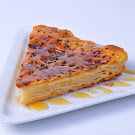WEST ASIAN CUISINE - Ⅰ
In
our previous posts, we have covered Northeast Asian cuisine to south Asian cuisine. We have
also shared some historical influences, staple food, ingredients and some
classical preparation. This one is all about the West Asian cuisine.
West Asia includes countries such as Saudi Arabia, Turkey, Armenia, Iraq, Israel, Kuwait, Lebanon, Azerbaijan, Bahrein, Jordan, Kuwait, Gaza strip, Yemen, west bank and Oman. South Asia, which tends to have lots of different religions but in West Asia there are two main religions that are Islam and Christianity. It is situated near by North Africa & Southeast Europe surrounded by seven separate seas which includes the Black Sea, Caspian Sea, Mediterranean Sea, Persian Gulf, Aegean Sea, Red Sea and Arabian Sea. Western Asian food has influenced by 2nd world war. Europeans invaded West Asia and brought ingredients like lemons and oranges. Ottoman empire also has strong impact on Western Asian food culture from 18th century till now. Persians brought nuts, cereals, eggplant etcetera which attracted West Asian and later on these. Ingredients become common. Neolithic revolution has changed the dietary culture of west food because people are allowed to raise crop and farm, domesticated animals such as camel, lamb, goat meat etcetera in early 10,000 BC.
Staple
Diet
The diet of people from west Asia constitute mainly of cereals. Wheat and rice are the major staple food consumed in the region; also barley is consumed on a very large scale while maize is becoming common in some regions. As pork is prohibited in both Islam and Judaism, lamb and mutton has always been the preferred meats in the region. Butter and clarified butter (also known as Samna) are traditionally as the preferred medium of cooking whereas olive oil is preferred in the Mediterranean coastal region. Prominently meat and vegetable stews are served along with the rice, breads and bulgur. Also preparations like grilled meats and kebabs are widely consumed.
In countries like Iran and Turkey, beverages like black and strong chai or tea, adding to this the vegetable & fruit juices, shakes and yogurt drinks are much admired. Due to the Islamic beliefs, alcohol is strictly forbidden in the region but on official permission, these alcoholic drinks are allowed to the people of other religion that too on the special occasions like wine communions in church.
Classical
Preparations
Chelo khoresh
A rice preparation topped with meat and vegetables
along with some spices cooked in a nutty sauce.
Polo chirin
A sweet and sour saffron rice preparation cooked along with raisins, almond and oranges.
Bint al-sahn
A multilayered sweet dish prepared in oven and
topped with honey with a sprinkle of habbatus sauda.
Abgoosht
An Iranian stew, prepared with lamb, chickpeas,
white beans, potatoes, tomatoes & turmeric, which is then strained and the
solids are mashed upon fully cooked.
A Levantine preparation, made with bulgur, minced lean beef, lamb, goat or camel meat, in cooperated with minced onion and flavorful & aromatic spices like cinnamon, cloves, nutmeg and allspice or with any savory filling.
Common
ingredients:
Sumac
A spice used mostly in the region, imparting a lovely
tart mild lemon flavor. The deep red berries are most often used which are then
grounded into the powder.
Dates
Also known as a date palm fruit, widely used in rice
preparation in the region.
Chickpeas
Widely used in stew preparations, imparting thickness and flavor to the dish, also known as garbanzo beans or Egyptian pea.
Did you know?
- Shawarma
is the most eaten food across this UAE.
- In
Oman coffee is always served with 5 or 7 numbers of dates.
- You'll
never find any Coco Cola product in Oman.
- Kuwaiti
cuisine is a fusion of Persian, Indian, Mediterranean and Arabian.
- Azerbaijan
has 40 varieties of Plov (Pilaf)







Knowledgeable.
ReplyDelete